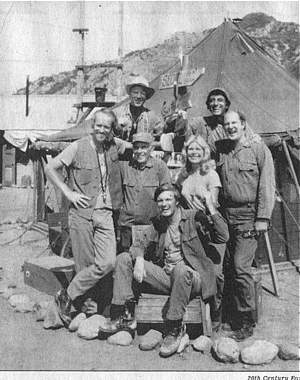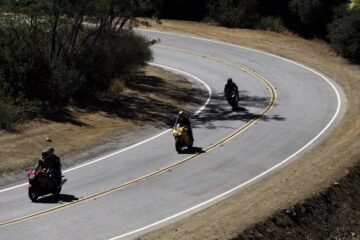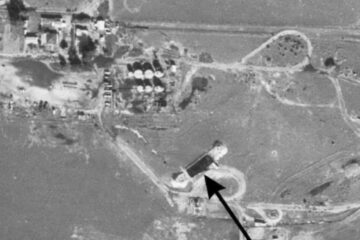Local peaks were a convincing cinematic stand-in
Source of this article – Los Angeles Times, January 21, 2007.
Cecilia Rasmussen

HIT SHOW: The cast of “M*A*S*H.” Only the hardiest hikers will trek along the rocky path to the site wher the series was shot.
Fans of the television series “M*A*S*H” would recognize this rugged terrain. In the show’s standard opening, two helicopters swooped over craggy peaks to land on a dusty plateau, where military doctors rushed to save the wounded soldiers aboard.
A magnificent backdrop — but not in South Korea.
The popular CBS-TV series, which ran from 1972 to 1983, was filmed in a remote area of the Santa Monica Mountains that is now part of Malibu Creek State Park, near Agoura Hills.
Few signs remain of the “M*A*S*H” set — only a rusty, burned-out Jeep, a 1940s ambulance and iron bars that once held the stairway to the helipad. This tranquil 10,000-acre park seems a world removed from the bustling freeways and congestion of nearby communities.
“This land has starred as faraway places for 80 years, and yet it’s right in our own backyard,” said Harry Medved, a publicist and the coauthor, with Bruce Akiyama, of “Hollywood Escapes,” a guide to Southern California film locations.
“There’s a strange sense of deja vu for movie buffs here,” he said in an interview. “It’s like one of those great Hollywood character actors — it looks kind of familiar, and you’ve probably seen it dozens of times, even though you may not know its name.”
As early as 1927, a Times film critic watched a silent movie called “Annie Laurie,” starring Lillian Gish, and believed this bit of California was the Scottish Highlands. Since then, the craggy landscape has doubled as Africa in “Tarzan Escapes” (1936) and “Five Weeks in a Balloon” (1962). It stood in for Wales in the best-picture Oscar winner “How Green Was My Valley” (1941).
A 25-foot-deep lake on the site was where the heroes of “Butch Cassidy and the Sundance Kid” (1969) plunged off a cliff to escape a relentless posse. It’s also where actor James Coburn’s stuntman jumped in “Our Man Flint” (1966).

NOT QUITE KOREA: Brian Rooney, left, Harry Medved and park ranger Mike Malone on the set of the TV series “M*A*S*H,” which was filmed in a remote area of what is now Malibu Creek State Park.
Medved is one of a trio of movie-location sleuths who will host “Walking the Movies,” a free hiking tour next Sunday in celebration of the landscape’s 80th anniversary in filmdom.
National Park Service ranger Mike Malone will lead the hike, accompanied by Medved and history buff Brian Rooney, author of “Three Magical Miles,” a local history book. Malone volunteers his time with the state parks.
“Each one of us is obsessed with uncovering the forgotten [movie] history of the Santa Monica Mountains,” Medved said.
Hikers will be guided about a mile down Crags Road, a fire road shaded by ancient oak trees, through rolling hills and past a meandering creek to the visitors center. The one-story white ranch-style house was built by a wealthy Angeleno, Willis Hunt, as a mountain retreat in the 1920s or early ’30s, according to Rooney.
Various costume changes have enabled the dwelling to play a part in several films. In “From the Terrace” (1960), it was dressed up to look like an Eastern estate where Paul Newman had a fling with Ina Balin. Studio magicians transformed it into a Southern plantation for the epic 1977 TV series “Roots.” It morphed into Sharon Tate’s Los Angeles home for the 2004 TV movie “Helter Skelter.” Dozens of historic production photos hang on the walls of the set-turned-visitors center.
Only the hardiest hikers will trek along the rocky path to the remote “M*A*S*H” site — and to volcanic formations surrounding what may have been a Hollywood skinny-dipping spot. The “rock pool” is believed to have made an appearance as part of Shangri-La in Frank Capra’s 1937 classic “Lost Horizon,” in which Jane Wyatt’s double swam nude before an enchanted Ronald Colman.
The pool plays a recurring role in film. Former “Charlie’s Angel” Tanya Roberts bared her breasts there for the sword-and-sorcery flick “The Beastmaster” (1982). Charlton Heston and fellow astronauts dropped their drawers for a dip in “Planet of the Apes” (1968). A fully clothed Rex Harrison talked to an alligator for 1967’s “Dr. Dolittle,” which won two Academy Awards. Actor James Keach gets chased around the pool by a snarling black panther in “The New Swiss Family Robinson” (1998). (Keach escapes by diving underwater. After shooting the scene, the leashed cat bit a trainer’s ankle, breaking the bone, according to a 1997 Times story. It was unclear what triggered the attack.)
Hikers will tour the stone foundations of the Crags Country Club and its surviving seven-acre lake, originally called Crags Lake and today known as Century Lake. It was created in 1901 after 100 wealthy Los Angeles businessmen bought 2,000 acres along Malibu Creek. Members of the exclusive club dammed the gorge to produce the small lake for sailing, fishing and duck-hunting. They planted a grove of redwoods, which still stands.
Annual dues were $1,000, but these movers and shakers could afford it: They included William May Garland, who ran the 1932 Olympic Games here; Judge Henry O’Melveny, head of a prominent legal family and father of the founder of a prestigious law firm; and John Griffin Mott, an attorney and scion of the Sepulveda family.
Mott built an adobe house on Malibu Creek in 1910. There, The Times has reported, he often played host to his longtime friend, President Hoover. The adobe was used in “Viva Zapata!” (1952), starring Marlon Brando.
During the Depression, the club withered. Aging members were no longer up to the drive from Los Angeles, which took nearly two hours, Rooney says.
One of the few who still made the trip was William Wales Mines, a real estate developer and aviation enthusiast who helped found Mines Field, the airport that became Los Angeles International. In 1939, he was fishing alone atop the 15-foot-high dam when he fell into the lake and drowned, The Times has reported.
In 1946, 20th Century Fox bought the Crags clubhouse and 2,500 surrounding acres, turning it into the studio’s back lot and renting it to outside productions. The three-story clubhouse interfered with camera angles; it was torn down in 1955 for the sake of panoramic views.
By 1970, Mott’s rain-damaged adobe had fallen into ruins.
In 1974, the state purchased Century Ranch for parkland, along with ranches belonging to Bob Hope and Ronald Reagan. Filming continued with special permission after Malibu Creek State Park opened in 1976, but today the area is primarily a family campground and a haven for day hikers and picnickers.
After the tour, visitors can see a two-story white Colonial built for the 1948 classic “Mr. Blandings Builds His Dream House,” starring Cary Grant and Myrna Loy. The posh “Connecticut country home” was built with movable walls to accommodate cameras. Today it’s a state parks administrative building that sits in front of campsite No. 37.
The “Walking the Movies” tour begins at noon Jan. 28 (2007). From the Ventura Freeway (101), take Las Virgenes Road three miles south to the park entrance. Meet at the kiosk near the restrooms in the lower parking lot. The tour is free, but parking is $8. An MTA bus connects with a ParkLINK Shuttle. For shuttle information, go to http://www.parklinkshuttle.com . For more information about the hike, call (805) 370-2301.



0 Comments